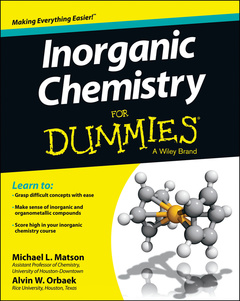Description
Inorganic Chemistry For Dummies
Authors: Matson Michael, Orbaek Alvin W.
Language: English
Subjects for Inorganic Chemistry For Dummies:
Keywords
Inorganic Chemistry For Dummies; Organic Chemistry For Dummies; Chemistry For Dummies; inorganic chemistry book; inorganic chemistry books; inorganic chem book; inorganic chem books; inorganic chemistry study guide; inorganic chem study guide; inorganic chemistry help; inorganic chem help; inorganic chemistry test prep; inorganic chem test prep; inorganic chemistry matson; inorganic chem; inorg; inorg chem; mike matson; Michael matson; IOchem; dummies inorg; dummies inorganic chem
23.63 €
In Print (Delivery period: 14 days).
Add to cart384 p. · 18.8x23.4 cm · Paperback
Description
/li>Contents
/li>Readership
/li>Biography
/li>
Inorganic chemistry can be an intimidating subject, but it doesn't have to be! Whether you're currently enrolled in an inorganic chemistry class or you have a background in chemistry and want to expand your knowledge, Inorganic Chemistry For Dummies is the approachable, hands-on guide you can trust for fast, easy learning.
Inorganic Chemistry For Dummies features a thorough introduction to the study of the synthesis and behavior of inorganic and organometallic compounds. In plain English, it explains the principles of inorganic chemistry and includes worked-out problems to enhance your understanding of the key theories and concepts of the field.
- Presents information in an effective and straightforward manner
- Covers topics you'll encounter in a typical inorganic chemistry course
- Provides plain-English explanations of complicated concepts
If you're pursuing a career as a nurse, doctor, or engineer or a lifelong learner looking to make sense of this fascinating subject, Inorganic Chemistry For Dummies is the quick and painless way to master inorganic chemistry.
Introduction 1
Part I: Reviewing Some General Chemistry 7
Chapter 1: Introducing Inorganic Chemistry 9
Chapter 2: Following the Leader: Atomic Structure and Periodic Trends 21
Chapter 3: The United States of Oxidation 39
Chapter 4: Gone Fission: Nuclear Chemistry 53
Chapter 5: The ABCs: Acid-Base Chemistry 69
Part II: Rules of Attraction: Chemical Bonding 81
Chapter 6: No Mr. Bond, I Expect You to π: Covalent Bonding 83
Chapter 7: Molecular Symmetry and Group Theory 101
Chapter 8: Ionic and Metallic Bonding 121
Chapter 9: Clinging to Complex Ions: Coordination Complexes 143
Part III: It’s Elemental: Dining at the Periodic Table 159
Chapter 10: What the H? Hydrogen! 161
Chapter 11: Earning Your Salt: The Alkali and Alkaline Earth Metals 171
Chapter 12: The Main Groups 183
Chapter 13: Bridging Two Sides of the Periodic Table: The Transition Metals 207
Chapter 14: Finding What Lies Beneath: The Lanthanides and Actinides 221
Part IV: Special Topics 233
Chapter 15: Not Quite Organic, Not Quite Inorganic: Organometallics 235
Chapter 16: Accelerating Change: Catalysts 253
Chapter 17: Bioinorganic Chemistry: Finding Metals in Living Systems 267
Chapter 18: Living in a Materials World: Solid-State Chemistry 287
Chapter 19: Nanotechnology 305
Part V: The Part of Tens 313
Chapter 20: Ten Nobels 315
Chapter 21: Tools of the Trade: Ten Instrumental Techniques 319
Chapter 22: Ten Experiments 323
Chapter 23: Ten Inorganic Household Products 329
Glossary 335
Index 343
Michael L. Matson is an assistant professor of chemistry at the University of Houston-Downtown where he instructs Inorganic Chemistry. Alvin W. Orbaek is a research assistant at Rice University, Houston, Texas, where he is completing his PhD in chemistry.
These books may interest you

IV Therapy For Dummies 19.92 €

Organic Chemistry I For Dummies 23.63 €

Chemistry For Dummies 22.39 €

